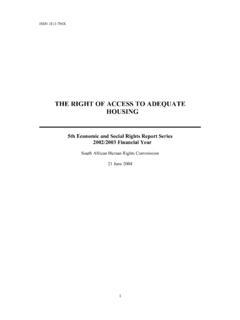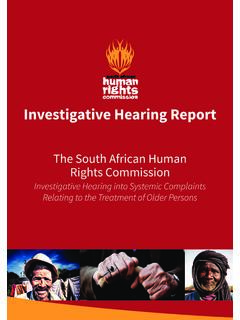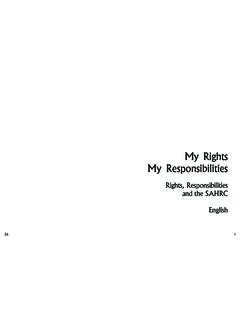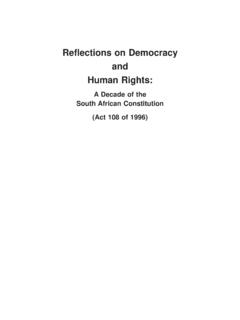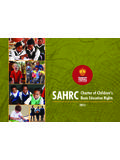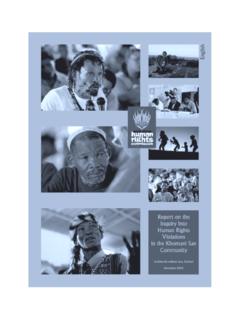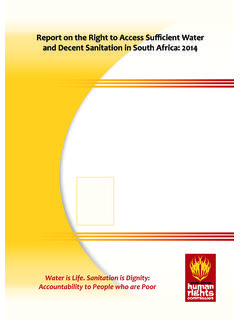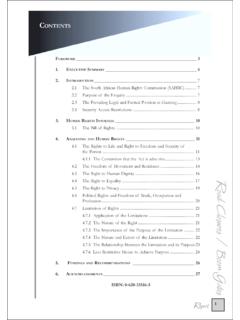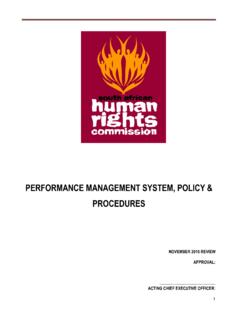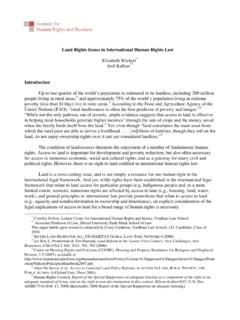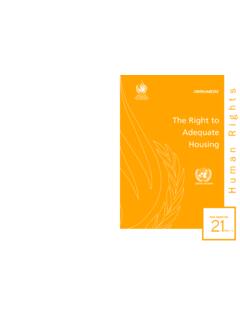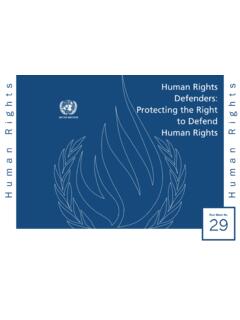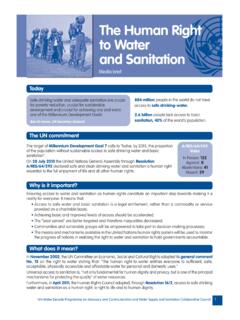Transcription of THE RIGHT TO ADEQUATE HOUSING - sahrc.org.za
1 THE RIGHT TO ADEQUATE HOUSINGFACTSHEET2 SAHRC | THE RIGHT TO ADEQUATE HOUSING FACT SHEETa breakdown in governance; inner city decadence and a mushrooming of informal settlements. The dawn of democracy in 1994 saw the new government s focus shifting to transformation and improved service delivery for all, through the introduction of integrated development plans (IDPs) to enable local government to deal with service delivery programmes. The intention was that IDPs would result in sustainable new HOUSING settlements located close to job opportunities, social services and economic development nodes. Informal settlements have been a contentious issue, with some of them located on land unsuitable for development but close to livelihood opportunities.
2 The perpetuation of apartheid geography and spatial planning remains a concern. The National Development Plan (NDP) recognises that South Africa is yet to achieve its NDPs objectives of breaking down apartheid spatial geography through land reform, more compact cities, decent public transport and the development of industries and services that use local resources and/or meet local needs. Urban areas remain divided along racial and class lines, which not only reinforce colonial and apartheid legacies, but denies spatial justice to the vast majority of our country s population What does the Constitution say? The RIGHT to HOUSING is enshrined in section 26 of the Constitution, which states that: 1) Everyone has a RIGHT to have access to ADEQUATE ) The state must take reasonable legislative and other measures within its available resources to achieve the progressive realisation of this RIGHT .
3 3) No one may be evicted from their home or have their home demolished without an order of court made after considering all the relevant circumstances. No legislation may permit arbitrary evictions. The RIGHT to ADEQUATE HOUSING is an important basic human RIGHT which is recognised in the Constitution and international human rights instruments. HOUSING provides shelter from the elements, a place to eat, sleep, relax and raise a family. The RIGHT to ADEQUATE HOUSING ensures that people enjoy physical and mental health and live in a safe place in peace and dignity. human rights are indivisible and interdependent, so the RIGHT to ADEQUATE HOUSING cannot be separated from the other rights such as sanitation, water, education, and healthcare.
4 The RIGHT to HOUSING is also inextricably linked to broader developments in the economy, labour markets, migration, demographic and other trends, which affect access to HOUSING . Failure to realise these rights and provide socio-economic goods and amenities in turn compromise the progressive realisation of the RIGHT to HOUSING . Historic BackgroundUnder apartheid, HOUSING segregation was mandated by law, which meant that non-whites could not live in white designated areas but had to live in designated non-white townships or in impoverished rural areas known as Bantustans or homelands. Very little HOUSING was provided for Africans, with difficult legal tenure requirements in urban areas being conditional on urban employment and on long leasehold or rental tenure, but thus were never allowed to own led to an increase in overcrowding in the black townships and a mushrooming of backyard dwellers.
5 The political reforms of 1983 introduced black local authorities and allowed for the sale of some homes rented by African persons from the state. Local authorities in the township then became the site of boycotts and protest politics as they attempted to raise revenue from an impoverished black population. By the end of the 1980s, townships were in a crisis as the HOUSING situation was characterised by severe and inadequate infrastructure and service delivery backlogs; a refusal to pay for basic services; SAHRC | THE RIGHT TO ADEQUATE HOUSING FACT SHEET 3 The Constitution outlines further protection by establishing the rights of children to basic shelter; entrenching property rights and providing that no one may be deprived of property except in terms of the law.
6 International recognition of the RIGHT to ADEQUATE HOUSING The Constitution provides that when interpreting the Bill of rights , a court, tribunal, or forum must consider international law; and may consider foreign law. It is for this reason that the international perspective on HOUSING is reflected in South African national legislation and Constitutional Court , the RIGHT to ADEQUATE HOUSING and protection from evictions, is enshrined in article 25 of the Universal Declaration of human rights (UDR) as well as Article 11 of the International Covenant on Economic, Social and Cultural rights (ICESCR). The provisions in these respective instruments recognise the inter-connectedness of social-economic needs and emphasise that HOUSING delivery must be planned to ensure that communities can access social services and economic opportunities.
7 Furthermore the Convention on the rights of the Child (CRC) imposes the obligation on state parties to assist parents with providing ADEQUATE HOUSING for their children. The International Convention of Civil and Political rights (ICCPR) guarantees that everyone is equal before the law and all parties to a dispute are entitled to a fair and public hearing by a competent and impartial judge or tribunal. The African Charter on human and People s rights (ACHPR) recognises the dignity of everyone, stating that everyone is equal before the law and has an equal RIGHT to protection of the law. Responsibility of the State / GovernmentSection 26 of the Constitution of the Republic of South Africa, mandates the state to take reasonable legislative and other measures within its available resources to achieve the progressive realisation of the RIGHT to ADEQUATE HOUSING .
8 To give effect to this obligation the state has enacted various pieces of legislation including the HOUSING Act 107 of 1997 (which came into effect on 1 April 1998) which provides: I. The national government, acting through the Minister, must after consultation with every Member of the Executive Committee (MEC) and the national organisations, representing municipalities, establish and facilitate a sustainable national HOUSING development process. II. Every provincial government through its MEC, must after consultation with the provincial organisations representing municipalities, do everything in its power to promote and facilitate the provision of ADEQUATE HOUSING in its province within the framework of the national HOUSING policy.
9 III. Every municipality must, as part of the municipality s process of integrated development planning, take all reasonable steps within a framework of national and provincial HOUSING legislation and policy, ensure that the inhabitants of its area of jurisdiction, have access to ADEQUATE HOUSING on a progressive basis. 4 SAHRC | THE RIGHT TO ADEQUATE HOUSING FACT SHEETTo ensure the progressive realisation of this RIGHT , the government in 1998 introduced the reconstruction and development programme (RDP). The RDP (which has subsequently been replaced by the Breaking New Ground (BNG) policy), is an integrated coherent socio-economic policy framework that seeks to mobilise everyone and mobilise the country s resources towards the final eradication of an apartheid style of HOUSING system in favour of an all-inclusive, non-racial HOUSING programme.
10 The current status of HOUSING in South Africa The RIGHT to ADEQUATE HOUSING is recognised as a socio-economic RIGHT . What constitutes ADEQUATE HOUSING is outlined in the HOUSING Act 107 of 1997, the BNG 2004 policy, and the National HOUSING Code 2009 (NHC), which provide for the facilitation of a sustainable HOUSING development process. The NHC specifies the minimum size of houses as 40 square meters of floor area with: a) Two bedrooms b) A separate bathroom with a toilet, a shower and a hand basin c) A combined living area and kitchen space with a wash basin d) A ready board electrical installation, where electricity supply is available. The state has committed to reversing and eradicating the apartheid spatial geography legacy.
